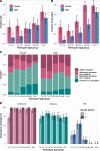Contact patterns of older adults with and without frailty in the Netherlands during the COVID-19 pandemic
- PMID: 37730628
- PMCID: PMC10510272
- DOI: 10.1186/s12889-023-16725-1
Contact patterns of older adults with and without frailty in the Netherlands during the COVID-19 pandemic
Abstract
Background: During the COVID-19 pandemic, social distancing measures were imposed to protect the population from exposure, especially older adults and people with frailty, who have the highest risk for severe outcomes. These restrictions greatly reduced contacts in the general population, but little was known about behaviour changes among older adults and people with frailty themselves. Our aim was to quantify how COVID-19 measures affected the contact behaviour of older adults and how this differed between older adults with and without frailty.
Methods: In 2021, a contact survey was carried out among people aged 70 years and older in the Netherlands. A random sample of persons per age group (70-74, 75-79, 80-84, 85-89, and 90 +) and gender was invited to participate, either during a period with stringent (April 2021) or moderate (October 2021) measures. Participants provided general information on themselves, including their frailty, and they reported characteristics of all persons with whom they had face-to-face contact on a given day over the course of a full week.
Results: In total, 720 community-dwelling older adults were included (overall response rate of 15%), who reported 16,505 contacts. During the survey period with moderate measures, participants without frailty had significantly more contacts outside their household than participants with frailty. Especially for females, frailty was a more informative predictor of the number of contacts than age. During the survey period with stringent measures, participants with and without frailty had significantly lower numbers of contacts compared to the survey period with moderate measures. The reduction of the number of contacts was largest for the eldest participants without frailty. As they interact mostly with adults of a similar high age who are likely frail, this reduction of the number of contacts indirectly protects older adults with frailty from SARS-CoV-2 exposure.
Conclusions: The results of this study reveal that social distancing measures during the COVID-19 pandemic differentially affected the contact patterns of older adults with and without frailty. The reduction of contacts may have led to the direct protection of older adults in general but also to the indirect protection of older adults with frailty.
Keywords: Behaviour change; COVID-19 pandemic; Contact survey; Control measures; Frailty; Older adults.
© 2023. BioMed Central Ltd., part of Springer Nature.
Conflict of interest statement
The authors declare no competing interests.
Figures





References
-
- Backer JA, Mollema L, Vos ER, Klinkenberg D, Klis FR van der, Melker HE de, et al. Impact of physical distancing measures against COVID-19 on contacts and mixing patterns: repeated cross-sectional surveys, the Netherlands, 2016–17, April 2020 and June 2020. Euro Surveill. 2021;26. 10.2807/1560-7917.ES.2021.26.8.2000994. - PMC - PubMed
Publication types
MeSH terms
LinkOut - more resources
Full Text Sources
Medical
Research Materials
Miscellaneous

